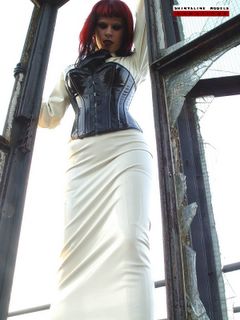L
Lacet Corset lacing--twisted or woven cord of silk, etc. (earlier called "point" (med.-c17th)
Lacing (Lace) Twisted or woven cord used to secure the corset, usually in the rear.
Lacing Bar Horizontal bar positioned high enough above a corsettee's head that she might grab and hang from it whilst being laced in. The technique lengthens the body and narrows the waist so that extreme tightlacing is possible.
Lacing Protector A piece of the corset without boning, or with light boning, the same length as the corset, and about three or four inches wide, depending on the corset size, made of the same color and fabric. Very good for protecting clothing and/or skin from the lacings perhaps pinching or scoring. It also allows the lacings to move more smoothly and assists in self-lacing by holding the lacings firm. In addition, it makes the corset look "finished" when the lacings are not totally closed.
Latex Raw material from which rubber is made; popular fetish material for corsets.
Long-Line Brassiére (Bra) A bra that extends to the waist and is often used for figure shaping and-/or smoothing.
Lacet Cuerda torcida o tejida de cordón para corsé normalmente hecha de seda (anteriormente llamada "punto" (a mediados del siglo XVII)
Barra del atado Es una barra horizontal colocada bastante más arriba que la cabeza de la persona que lleva el corsé de modo que ella pueda ser que se sujete y se cuelgue de la barra mientras que le atan el corsé. La técnica alarga el cuerpo y enangosta la cintura de modo que el atado extremo sea posible.
Protector Se trata de una pieza del corsé sin refuerzos ni ballenas, tan largo con el corsé y de unos tres o cuatro pulgadas de ancho, para evitar el roce de los cordones del corsé con la piel o
Latex Materia prima hecha con caucho; muy popular entre los fetichistas de los corsés.





















